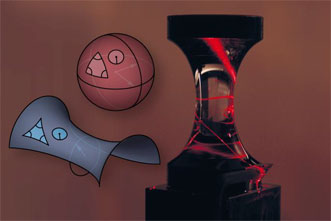A method for studying the influence of gravity on the propagation of light has enabled laboratory study of surface curvature, a material property that could be leveraged to improve manufacturing of integrated optical circuits or micro-optic components.
According to Einstein's general theory of relativity, gravity can be described as the curvature of 4D spacetime. In this curved space, celestial bodies and light move along geodesics, the shortest paths between two points.
Researchers from Friedrich Alexander University Erlangen-Nuremberg (FAU) and Friedrich Schiller University Jena, led by professor Ulf Peschel, sought to examine the propagation of light in such curved spaces in the lab using intensity interferometry, a measurement technique pioneered by the English physicists Robert Hanbury Brown and Richard Twiss, and used to determine the size of stars that are close to the sun.
In intensity interferometry, two telescopes are set up some distance apart and focused on a star that is to be examined. The fluctuations in light intensity measured by the two telescopes are then compared. Fluctuations in intensity are a result of the interference of light emitted separately from the surface of the star — visible as a pattern of light dots in the images produced — and allow conclusions to be drawn about the size of the object that is observed.

A laser beam in an experiment propagates along the two-dimensional surface of a glass object shaped like an hourglass, curling once around the middle of the object. This is an example of an object with negative surface curvature, like a saddle, in contrast to an object with positive surface curvature, such as a sphere. Courtesy of Vincent Schultheiss.
As paths of light in curved space tend to converge or diverge much more frequently than in flat space, the size of the dots changes depending on the curvature. The researchers were able to show that knowing the curvature is crucial for interpreting results and that experiments that use interferometry are suitable for measuring the general curvature of the universe more exactly.
“The main goal of our research is to transfer findings based on the general theory of relativity to materials science by carefully modelling the surfaces of objects,” Peschel said. “From a manufacturing point of view, flat designs are often much easier to achieve. However, curved surfaces have a potential that has not yet been exploited and could be used to control light paths in optical systems, for example. Creating local variations in the surface curvature can often have the same effect as changing the volume material itself. This could allow the number of steps required and materials used when manufacturing integrated optical circuits or micro-optic components to be reduced.”
The research was published in Nature Photonics (doi: 10.1038/nphoton.2015.244).